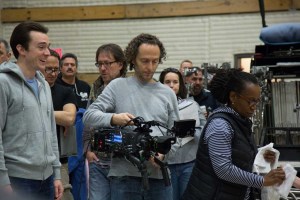
“Birdman was so experimental and so difficult that each step was like walking through a minefield,” said the film’s Oscar-winning director of photography, Emmanuel (Chivo) Lubezki. The movie is a black comedy about a former movie superhero who is desperately trying to relaunch his moribund career by directing and starring in a Broadway show.
The mind-boggling complexity of shooting the movie grew out of director-screenwriter Alejandro González Iñárritu’s audacious idea of making Birdman look as if it had been shot in just one long take. Though practically impossible to pull off as a single shot, the film indeed consists of a continuous string of single-take stretches, some as long as 20 minutes, which are stitched together with some seemingly invisible deft edits.
While it’s hard not to be wowed by the virtuosity of Lubezki’s cinematography, the goal of the movie’s unique approach to filming is not to dazzle cinematography geeks with showy technique but to immerse audiences in the main character, Riggan Thomson, played by Michael Keaton who is on a career and life rollercoaster. Birdman is being called the role of Keaton’s career.
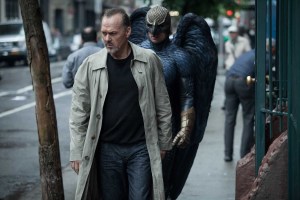
The use of the long camera takes sparked the actors’ performances, according to the DP, as if they were actually in a play. “Because the takes were so long and complex and everybody had to be so concentrated and so focused, obviously no one wanted to be the one messing up a 20 minute shot,” he said. “This brought incredible energy into the movie. Not just the technical aspect but the emotional aspect.”
Meanwhile the DP and his crew were pushed to the limits, in terms of logistics, camera moves and lighting challenges. The camera was almost constantly moving, and Lubezki needed to be able to shoot 360 degrees. He almost entirely relied on existing or practical light sources without adding any of his own, and he had to stay with the actors for every beat.
One of Birdman’s more hilarious episodes was also “incredibly complicated to shoot because we did it in Times Square with Michael moving through in his underwear.” The scene begins with Riggan, gathering his thoughts before he’s about to get dressed and go on stage, taking a smoking break outside the fire door wearing only his skivvies. He finds he’s locked himself out, and has to cross crowded Times Square, and then head back to the theater. He re-enters through the front door, and walks down the main aisle. The audience doesn’t know if this is part of his role or a joke as he ascends the stage.
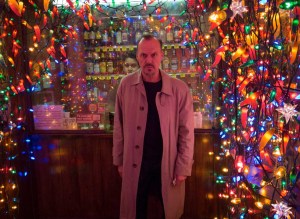 Birdman had a frugal $19 million budget. It would have cost too much to clear Times Square for the shoot. The solution: Iñárritu discovered a talented band of young people performing in downtown New York and decided they could be inserted in Times Square, where their presence would seem natural. They started to play loudly just as Keaton walked through. That attracted the attention of bystanders who then ignored the actor, striding by surrounded by 20 extras while the camera crew was shooting.
Birdman had a frugal $19 million budget. It would have cost too much to clear Times Square for the shoot. The solution: Iñárritu discovered a talented band of young people performing in downtown New York and decided they could be inserted in Times Square, where their presence would seem natural. They started to play loudly just as Keaton walked through. That attracted the attention of bystanders who then ignored the actor, striding by surrounded by 20 extras while the camera crew was shooting.
The take continued as Keaton returned to the theater, walked down the center aisle headed back to the stage with a large audience on either side. “It was a very narrow aisle, and the camera which was following him had to go around him and past him, without pushing Michael and without destroying the pace of his acting,” recalled Lubezki.
Lighting was another difficulty. “I needed to achieve naturalistic, realistic-looking lighting that was coming from actual sources, so it could tell the story and at the same to be functional for all the needs of the camera,” he said. The DP used illumination from the play on stage to light Riggan’s face. “It’s kind of wonderful. It reveals his state of mind.”
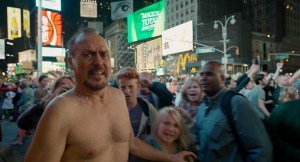 Filming the audience was also a trick, since extras were only in the seats close to the aisle, again to save money. The other seats were filled with dummies. “The lighting had to be very specific, enough to show the extras but not too much because you would notice there were dummies in most of the seats.”
Filming the audience was also a trick, since extras were only in the seats close to the aisle, again to save money. The other seats were filled with dummies. “The lighting had to be very specific, enough to show the extras but not too much because you would notice there were dummies in most of the seats.”
While Birdman is made up of a few lengthy shots strung together, that doesn’t mean there weren’t a lot of takes. “For some of the shorter scenes we did as many as 25 takes, but others you couldn’t more than 3 times at most,” he noted.
The film couldn’t haven’t been shot the way Iñárritu wanted without elaborate advance preparations. A little proxy stage was built in in Los Angeles at Sony Pictures. Rudiments of a set were assembled piece by piece while camera moves and blocking were being refined for each scene. There were even stand-in actors hired to perform the entire movie so that camera angles could be figured out. “By the time we got to New York we were pretty clear about how the camera would be moving.”
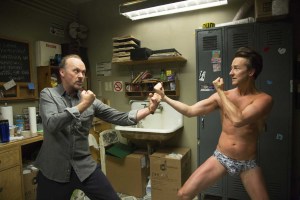 Lubezki shot digitally with ARRI cameras, specifically the Alexa M and XT. The M was chosen for its light weight and small size, which made it maneuverable for handheld lensing in tight quarters and for the sheer endurance of doing extended takes. The XT was mounted on Steadicam. Chris Haarhoff was the Steadicam operator.
Lubezki shot digitally with ARRI cameras, specifically the Alexa M and XT. The M was chosen for its light weight and small size, which made it maneuverable for handheld lensing in tight quarters and for the sheer endurance of doing extended takes. The XT was mounted on Steadicam. Chris Haarhoff was the Steadicam operator.
Birdman is the first movie that Lubezki has photographed for Iñárritu. Both are from Mexico and first met some 25 years ago when Iñárritu was a DJ in Mexico City. The two started making commercials together. They are currently collaborating on another movie, The Revenant, an early 19th-century story of revenge starring Leonardo DiCaprio and Tom Hardy.
Lubezki won an Academy Award in 2014 for best cinematography for space-epic Gravity, directed by Alfonso Cuaron. He has five other Oscar nominations: A Little Princess and Children of Men, both also helmed by Cuaron. He received nods for two films done with director Terrence Malick, Tree of Life and The New World. And his cinematography on Sleepy Hollow for director Tim Burton was also nominated for an Oscar. Lubezki has three times received the award for best feature cinematography from the American Society of Cinematographers for Gravity, Tree of Life and Children of Men.





